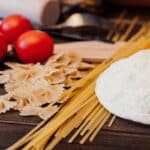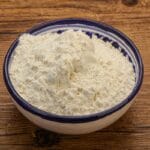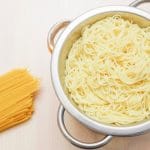In summary: Yes, you can freeze cooked and drained spaghetti squash in an airtight bag, but it will be slightly softer than fresh.
Although not quite the same as wheat spaghetti, spaghetti squash does make for a great gluten-free, vegetable pasta substitute. This type of winter squash has a mild flavor that allows it to be paired with a variety of sauces, spices, and herbs.
Spaghetti squash is best frozen cooked after which the flesh pulls apart to form thin spaghetti-like strands. This allows you to keep leftovers or prepare spaghetti squash ‘noodles’ in advance for a quick-fix meal.
Here is a full guide to freezing spaghetti squash for best quality preservation.
Can Spaghetti Squash Be Frozen?
Yes, you can freeze cooked spaghetti squash for future use, but there are a few important factors to keep in mind when doing so.
The squash will be slightly softer than when it is cooked fresh, but the overall flavor and quality will remain mostly unchanged.
For the best results, the squash should be frozen only after it has been cooked and drained. If the squash has not been drained, the excess moisture will likely cause the squash to become mushy mess on thawing and reheating.
Do not package or freeze spaghetti squash while it is still warm. The condensation will cause more moisture. This will, in turn, result in freezer burn and a soggy texture once thawed.
One more way to protect the squash from spoiling during freezing is by keeping it in an airtight freezer safe bag to protect it from contact with air and moisture.
How To Freeze Spaghetti Squash
Step 1: Clean and Cut
Even though you won’t be using the skin of the squash, it is a good idea to give it a rinse. Once rinsed and dried, cut the spaghetti squash in half lengthwise.
Step 2: Remove Seeds
Using a spoon, scrape out all the seeds. You can either keep the seeds to roast them for snacks and salad toppings or discard them.
Step 3: Cooking Spaghetti Squash
Place the squash halves on a baking sheet with the cut side facing upwards. Bake the squash at 400 °F (200 °C) for 30 to 40 minutes or until fork tender. Alternatively, you can also steam the squash.
Do not overcook the squash as reheating it after thawing will cook it further. Slightly undercooked is better than overcooked.
Step 4: Cool
When ready, remove the cooked squash from the oven. Let the squash cool for 30 minutes. When cool enough to handle, run a fork lengthwise through the flesh of the squash to remove it from the skin and separate it into strands.
Step 5: Drain
Scoop all the spaghetti squash strands into a colander. Place the colander over a large mixing bowl that can catch the draining liquid. Make sure there is a space between the bottom of the bowl and the colander so that the spaghetti strands don’t soak in the liquids.
Place the bowl and colander overnight in the refrigerator to let the noodle like strands drain.
Step 6: Pack
Once drained, remove the colander from the fridge and scoop the spaghetti squash strands into a resealable freezer bag or airtight container.
If you are freezing a large batch, divide it into smaller portions for freezing. Lie the freezer bags flat and carefully press out as much air as possible before sealing fully.
Step 7: Label and Freeze
Label the freezer safe bags with the date and contents and place it in the freezer.
How To Thaw Frozen Spaghetti Squash
Spaghetti squash can go straight from the freezer into the steamer or microwave on medium heat. Frozen spaghetti squash will thaw and heat up quickly so be careful not to overcook it, especially when using the microwave. Also make sure you are using a microwave safe container.
If you are adding frozen spaghetti squash to a pasta sauce, making a casserole, or using it in a baked dish, let it thaw in the refrigerator for one to two hours.
Types of Spaghetti Squash
Although spaghetti squash is prepared and eaten as a vegetable, it is botanically classified as a fruit. It is available in a variety of sizes and is generally ivory, yellow, or orange in color. The center is filled with large seeds, similar to butternut squash or pumpkin seeds. These can be salted, toasted, and eaten as a healthy snack, sprinkled over salads, or over your favorite spaghetti squash recipes.
This ‘vegetable spaghetti’ has firm flesh that softens and loosens in thin strands when cooked. The squash can be cooked by boiling, steaming, microwaving, in a slow cooker, or instant pot. However, our favorite way to prepare it is by making roasted spaghetti squash.
It can be eaten on its own as a side dish with olive oil or butter and herbs, stuffed, used as a pasta substitute in bolognese, and baked into a casserole. Since the flavor profile is subtle, the noodle squash pairs well with tomato sauce, your favorite meat sauce, cheese sauces, and much more.
FAQs
Conclusion
Whether eaten stuffed, roasted, steamed, in an omelet, casserole, or as a low carb, gluten free alternative to pasta, spaghetti squash is a delicious and colorful addition to breakfasts, lunches, and dinners.
This vegetable freezes well when cooked and drained beforehand, with its flavor and texture remaining mostly unchanged.
Whether you are saving leftovers or doing healthy meal-prep for convenient week-night dinners, freezing cooked spaghetti squash is worth the extra bit of effort.
Not only is it quick to defrost, but you can put a meal together in almost no time when you have a stash of prepared spaghetti squash in the freezer ready to go.
Also check our guides on how to freeze zucchini noodles, spaghetti noodles, and butternut squash.

*image by urban_light/depositphotos









